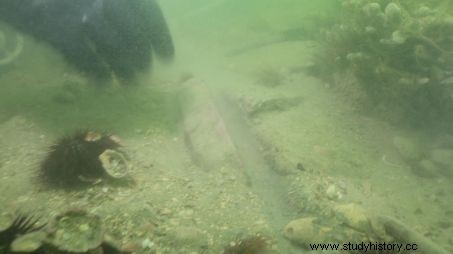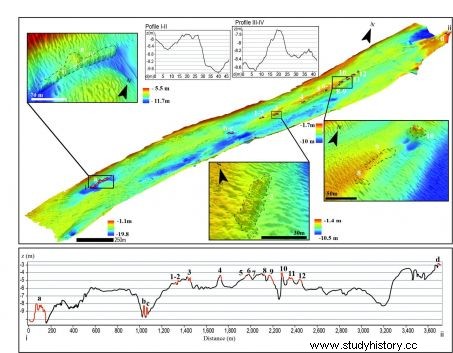The Romans were able, over time, to build an important road network whose remains are now discovered under water, especially in the lagoon of Venice.

On the left, the reconstruction of the Roman road in the Treporti canal in the Venice lagoon and on the right, the same area now submerged.
In the lagoon of Venice, Italy, rests forever a Roman road unearthed by a team of researchers from the University of Venice and the Italian Institute of Marine Sciences.
Roman control beyond the land
The Romans were able, over time, to build an important road network. This has extended over tens of thousands of kilometers to best serve all of their territories. To the delight of archaeologists, "several portions of this ancient road network are still well preserved after more than two millennia in numerous archaeological sites in Europe, the Middle East and North Africa ", reveals a new study published on July 22, 2021 in the journal Scientific Reports .
But these are the roads immersed in the land and which constitute only a part of the Roman constructions. The control of the Empire continued beyond, in the lagoons, the marshes and the deltas. The roads therefore had to be extended into navigable waterways.
In the lagoon of Venice, Italy, rests forever a Roman road unearthed by a team of researchers from the University of Venice and the Italian Institute of Marine Sciences.
Roman control beyond the land
The Romans were able, over time, to build an important road network. This has extended over tens of thousands of kilometers to best serve all of their territories. To the delight of archaeologists, "several portions of this ancient road network are still well preserved after more than two millennia in numerous archaeological sites in Europe, the Middle East and North Africa ", reveals a new study published on July 22, 2021 in the journal Scientific Reports .
But these are the roads immersed in the land and which constitute only a part of the Roman constructions. The control of the Empire continued beyond, in the lagoons, the marshes and the deltas. The roads therefore had to be extended into navigable waterways. In this new study, the researchers then ask:"what was the role played by the Venetian Lagoon, the largest lagoon in the Mediterranean Sea, surrounding the historic city of Venice (Italy)? And to add:"we know that in Roman times the relative mean sea level was lower than today and large parts of the lagoon, which are now submerged, were accessible by land ". Already several remains of Roman origin have been discovered in the water or buried in the seabed of the lagoon. With their discovery, the scientists wish to trace in a precise way the common history of Venice and the Romans. They have therefore surveyed a particular area, now known as the Treporti channel, to the north of the lagoon.
A road built with basoli
The researchers carried out an underwater mapping using sonar. In this way, they spotted at less than 6 meters depth, 12 regularly shaped structures aligned in a northeast direction for 1,140 meters and measuring up to 2.7 meters high and 52.7 meters long. Given their arrangement and location, they are anthropogenic structures. "The 12 structures are the remains of a road. They are actually agglomerates of stones along an alignment of more than 1 km “, explains to Sciences et Avenir Fantina Madricardo, lead author of this new study. Already a survey carried out in the 80s had revealed the presence of stones having "a smooth upper side, while the lower part had an ovoid shape". "This lithic morphology was similar to that of Roman basoli, stones normally used to cover the upper surface of ancient roads ", recalls the new study.

Imbricated stone found by divers in the channel. Credit:Squadra Sommozzatori della Polizia di Stato di Venezia
Other cobblestones of this type were still discovered in 2020. Another group of works was unearthed. Four in number, they measured up to 4 meters high and 135 meters long. The largest of these structures may have belonged to a port, and was possibly part of a wharf.

The numbers 1 to 12 indicate the alignment of the structures. The letters a to d identify the four other structures found in the area. Credit:Federica Foglini
This study aims to shed new light on the occupation of the lagoon before the construction of the historic Italian city in the 5th century. Did the Romans establish permanent structures there? "The submerged road represents, probably, one of the last stretches of road in Altinum's seascape (disappeared Roman city which was located near the lagoon of Venice, editor's note), within a wider network of roads “, suppose the researchers. A permanent colony could therefore have been established in the region. And “this area was crossed by travelers and sailors “, explain the researchers who marvel at “the ability of the Romans to adapt and manage complex dynamic environments that were often radically different from today ".
